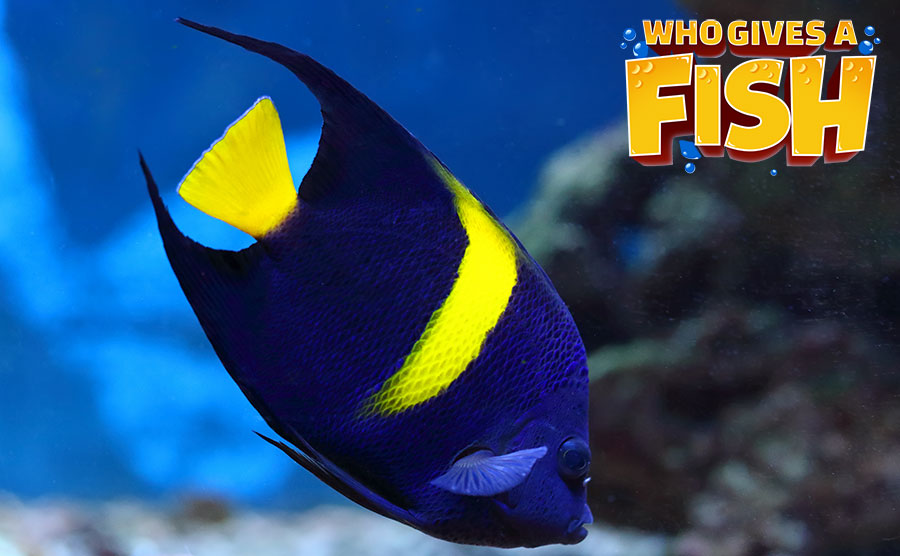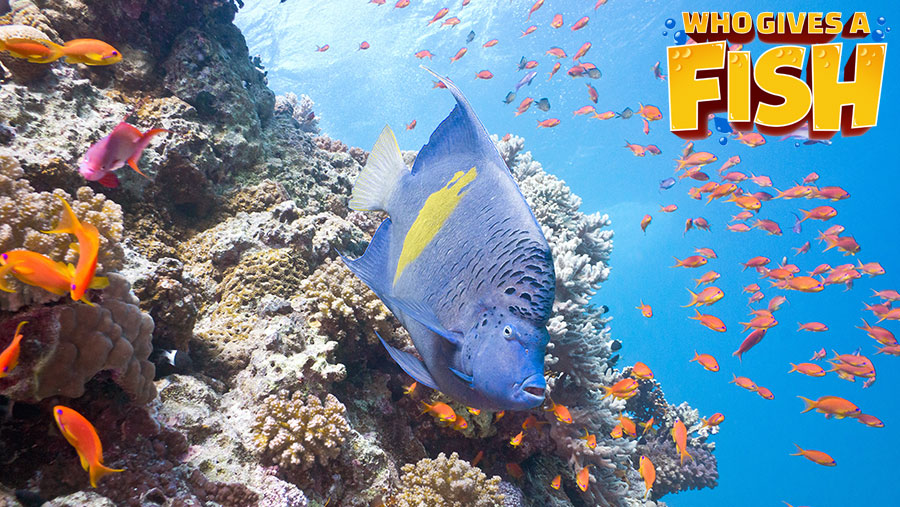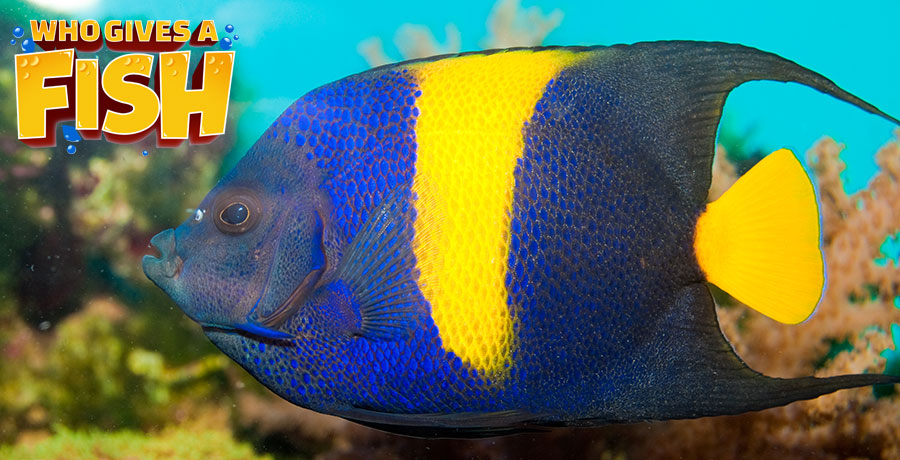Arabian Angelfish
The Arabian Angelfish, Pomacanthus asfur, is extremely gorgeous, as both a young fish and as an adult fish. The adult possesses a royal blue body, combined with a strong yellow tail and a big, broad, yellow “V” formed stripe. Younger fish have an deep blue with white and light-blue stripes. Throughout both stages of life, this particular angel really is a dazzling eye catcher. Other accepted names are the Half Moon Angelfish, Asfur Angelfish and the Crescent Angelfish.
- Experience Level: Intermediate to Experienced
- Hardiness: Can be difficult to keep healthy
- Minimum Tank Size: 150 gal (568 L)
- Size of fish: 16 inches (40.64cm)
- Temperament: Semi-aggressive
- Temperature: 72.0 to 82.0° F (22.2 to 27.8° C)
- pH Range: 8.1-8.4
- Diet: Omnivore
Table of Contents
Introduction
Aquarium Setup
Difficulty
Feeding
Breeding and Social
The Arabian Angelfish has strong colors, but not the superior personality that is found in some other larger angels. These specific angelfish are among the shyest of the Pomacanthus group, but with a kinder nature. Yet, as with a majority saltwater fish, they will not stand for other angelfish, and can be very combative towards their own kind, unless in a couple.
As they adapt and become more content within their tank, they may bully any new tank mates, or other passive fish. So long as the harassed fish is still eating and not hiding, they should both adapt.
The Arabian Angelfish has been known reach up to 16 inches (41 cm) in the wild, and when housed in a tank that is of ample size, but they seldom grow beyond 9.6 inches (24 cm) while in captivity. They will still require a reasonably sized tank in order to reach their bright coloration and full captive capacity. These angelfish are more inclined to stress than other fish of similar size when not supplied with an ample amount of room to swim. Their shyer nature leads them to requiring several hiding areas in order to feel safe. A young fish can start off in 150 gallons (568 liters), but an adult certainly needs at least 250 – 300 gallons (950 – 1135 liters) to be comfortable, and in order to acquire its brilliant adult colors. Their shallower water choices in the wild necessitate a higher temperature tank than what is required for deeper residing fish. In a few cases, there is no demand for a chiller with these particular fish.
So long as proper tank criteria is met, the Arabian Angel can acclimatize and is fairly rugged as an adult. The safer this fish feels, the more it will appear in the open. Having too small of a swimming area for these larger angels will result in a deficiency of full adult coloration, a shorter life span and undue stress. Combative tank mates will also hinder this angel from appearing, causing it stress.
Arabian Angelfish are usually not thought of as reef safe. Yet you may be able to house them with small polyp stony corals (SPS) and very soft, noxious corals. Naturally, those two kinds of coral are not usually kept together, however a tank full of one or the other would be good. Keeping your angelfish fed well will also aid in the fish not wanting to nibble on the coral.
Aquarium Setup
The Arabian Angelfish, like many other large angels, needs a consistent habitat which is at least 6 months old. A tank needs to be at least 150 gallons (568 litres), but an adult truly requires at least 250 – 300 gallons (950 – 1135 l) to acquire the correct size and color. The tank ought to be well adorned with coral and rocks arrangements with various of hiding places, particularly for juveniles. Provide water criteria of: 72-85° F, pH 8.1-8.4, sg 1.023-1.025. Asfur Angelfish require proper reef-like lighting or they can contract HLLE (Head and Lateral Line Erosion Disease).
Usually, Pomacanthus angelfish are not as merciful as other fish when it pertains to the quality of water. Making sure that water quality on the higher side is essential with angelfish. Water changes of 15% every 2 weeks or 30% a month, is ideal for keeping nitrates low. If corals are in the tank, then 5% a week, 10% every 2 weeks or 20% every month works well.
A big tank is essential for this huge fish. As it requires a lot of food, there is a big bio-load on the aquarium and a smaller tank will become dirty fairly quick. A proposed guideline is to keep up with your water analysis, which will disclose when your tank requires a water change.
Arabian Angelfish Aquarium Guide
- Minimum Tank Size: 150 gal (568 L) – 150 gallons (568 litres) is adequate for a juvenile. A tank that is 250 to 300 gallons (950 – 1135 l) will help them obtain proper color and size, and to keep a male/female pair.
- Suitable for Nano Tank: Absolutely NOT!
- Live Rock Requirement: Typical Plus Hiding Places – Hiding places are needed to help the angelfish feel secure.
- Substrate Type: Any
- Lighting Needs: Moderate – normal lighting – It is best kept under normal lighting, but can also be kept in sunlit conditions as well as a dimly lit tank. Lighting is needed to provide algal crops on live rock.
- Temperature: 72.0 to 82.0° F (22.2 to 27.8° C)
- Specific gravity: 1.019-1.025 SG
- pH Range: 8.1-8.4
- Brackish: No.
- Water Movement: Any – No special requirements, the Asfur Angelfish can tolerate a rather stronger flow but slow-moving water is preferable.
- Water Region: All – They will spend time in all parts of the aquarium providing there are no threats and there is enough space for them
Difficulty
The Asfur Angelfish are fairly hard to maintain as juveniles and fairly simple as adults if given ample room. They are deemed to be more for intermediate to advanced aquarists only due to the big size of the tank required to properly house them. If a tank of 250 gallons (950 l) or more is able to be supplied, then they would be deemed fairly rugged as adults. This is owing to lower stress levels that result from sufficient swimming room. An adult that is well accustomed will become a very rugged fish, and will even come up to the surface and receive foods from its guardian.
Feeding
Arabian Angelfish are an omnivore. When in the wild, they consume an extensive variety of sponges with bryozoans, tunicates, hydroids and small amounts of algae. It is crucial that you supply the angelfish all kinds of prepared formula foods, frozen and live foods. Supply vegetable based foods along with meaty foods like shrimp, scallop and chopped squid. Prepared foods with tunicates and marine sponge are necessary. Foods that contain color enriching qualities can be used as well. An excellent formula that can be made at home that consists of spinach, mussels, squid and shrimp. Make sure to feed 3 or more times a day. Regular smaller feedings will aid them to be more amiable and in better condition.
Arabian Angelfish Feeding Guide
- Diet: Omnivore – Use products with Spirulina added if there is not enough algae in the tank.
- Flake Food: Occasionally – With Spirulina and sponge material included, and color enhancing foods are also helpful.
- Pellet / Tablet: Occasionally – With Spirulina and sponge material included.
- Live foods (fish, shrimp, worms): Some of Diet – Brine shrimp, Mysis shrimp, as well as other protein sources can be offered occasionally.
- Vegetable Food: 85% of their diet
- Meaty Food: 15% of their diet – Too much meaty foods will cause vitamin deficiencies.
- Feeding Frequency: Several feedings per day – Minimum 3 times a day. They need several small feedings a day that include mainly vegetable matter and sponge material, and sometimes meaty foods.
Breeding
There has been little success in tank breeding and also with tank reared Pomacanthus asfur . However, successful breeding can only be attained in an extremely big display aquarium. Some home aquarists will not possess a tank big enough to stimulate spawning with this particular angelfish.
As with some saltwater fish, they begin to feel playful around dusk. The male Asfur Angelfish will glide about the female briskly, in a circular motion, and will then abruptly swim over her to see if she is prepared. In time, she will feel obliged to swim over to him. He will then nuzzle her stomach with his nose in order to spark her to lay her eggs. At the time she discharges her eggs, he will free his sperm. These freshly fertilized eggs will drift around in a planktonic phase for a couple of weeks. Finally, they will finish up at the bottom as fry and begin their colorful life away from their parents.
Social
They are generally peaceful fish if given enough room in a large community tank, but can be semi aggressive in any crowded situation. You should consider the long term effect on the community tank given this species potential size.




